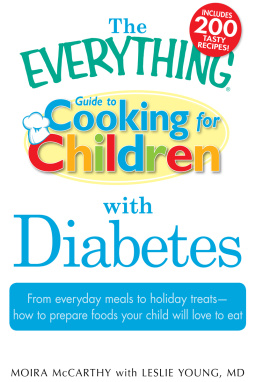
Copyright 2006, 2010, 2017 by Barbara Grunes.
No part of this book may be reproduced or transmitted in any form or by any means, electronic or mechanical including photocopying, recording, or by any information storage or retrieval system without express written permission from the publisher.
Nutritional analyses: Linda R. Yoakam, RD, MS
Diabetes Snacks, Treats, and Easy Eats for Kids, 3rd Edition
ISBN 13: 978-1-57284-792-7
First printing: March 2017
The Library of Congress has cataloged the first edition of this work as follows:
Library of Congress Cataloging-in-Publication Data:
Grunes, Barbara.
Diabetes snacks, treats & easy eats for kids: 130 recipes for the foods kids really like to eat / Barbara Grunes, with Linda R. Yoakam.1st U.S. ed.
p. cm. Includes index.
1. Diabetes in childrenDiet therapyRecipes. 2. Diabetes in adolescenceDiet therapyRecipes. I. Yoakam, Linda R. II. Title. III. Title: Diabetes snacks, treats and easy eats for kids.
RJ420.D5G78 2006 641.56314dc22
10 9 8 7 6 5 4 3 2 1 17 18 19 20 21
Surrey is an imprint of Agate Publishing. For more information, go to agatepublishing.com.
DEDICATION
I WOULD LIKE TO DEDICATE THIS BOOK to the diabetics in my life: Edith Maniff, my mother; Jerome Grunes, M.D., my husband; Gary Maniff, my brother; Virginia Van Vynckt, my friend and fellow food writer.
And most recently, Reba Georgiadis, my daughter.
And to my consultants, my grandchildren: Avi, Marissa, Big Natalie, Claire, Suzie, Big Noah, Ethan, Natalie, and Noah.
This edition of Diabetes Snacks, Treats, and Easy Eats for Kids has been updated by the publisher with carefully selected content from Diabetes Snacks, Treats, and Easy Eats, which was originally published by Barbara Grunes in 2004.
Table of Contents
Guide
CONTENTS
AS A NATION we are fat and our children are, too. American children have a 30 percent chance of becoming obese adults. We have learned that being overweight dramatically increases the chances of developing diabetes and greatly increases the health risks and complications for a person with diabetes. And like overweight adults, our children are developing diabetes in numbers that are truly frightening. Children are no longer the victims of just Type 1, or juvenile, diabetes; they are now falling prey to Type 2, a preventable disease that used to strike primarily older adults.
Today, adults and children with diabetes are working with their doctor, registered dietitian, or certified diabetes educator to develop individualized eating plans. They are learning about portion control, how to count carbohydrates or exchanges, and, for those who take insulin, how to adjust their insulin doses accordingly.
We need to do something now to stop this epidemic, and we need to start with our children. As parents, healthcare providers, and caretakers, we should focus on how to encourage the consumption of good, wholesome foods, not on how to make junk food less junky.
This book is Barbaras contribution toward that end. She provides recipes for nutritious foods that are easy to prepare and delicious to eat. She also makes it doable for the time-challenged home cook by limiting recipes to as few ingredients as possible. Complete nutritional information, including exchanges, is provided for each recipe.
Until the final research work is in, and until you have a chance to developwith a healthcare provideran individualized eating plan for yourself or your child, there are several ways to improve your current health and safeguard your future health: Practice portion control; eat a variety of foods, especially whole grains and colorful vegetables and fruits; reach and/or maintain a suitable weight; and make exercise a daily part of your life.
Deborah Edidin, M. D.
PEDIATRIC ENDOCRINOLOGIST
NORTHWESTERN UNIVERSITY MEDICAL SCHOOL
DIABETES IS A DIFFICULT DISEASE for anyone to deal with. But it can be especially hard for children and even more so for their parents to live with diabetes in a culture that considers glorified cookies a breakfast food and where the typical restaurant childrens meal is a hot dog and French fries. The child-friendly recipes youll find here offer a positiveand tastyalternative.
Like many American adults, too many children are also overweight, sedentary, and diabetic. Today, children as young as 10 years old are being diagnosed with Type 2 diabetes, which used to be thought of as a disease of older adults. But with a poor diet and inactive lifestyle, children, too, are developing diabetes.
The good news is that life is easier for both adults and children with diabetes than it used to be. Improved medications, insulin delivery, and blood sugar monitoring technology make it easier to keep your childs blood sugar under control. A wealth of good-tasting, reduced-sugar, and no-sugar foods, plus tons of healthy convenience foods such as peeled baby carrots, bagged salads, and cut-up fruit, make it easy to plan healthful snacks and meals not only for your diabetic child but for your entire family. This recipe collection is designed to help you do just that.
Recommended diets for those with diabetes have loosened up a lot from the old days. For the most part, even sugary and rich foods are not forbidden. Children with diabetes can have sweets in moderate amounts as long as the sweet counts as part of their overall daily carbohydrate intake. Ten percent of ones total carbohydrates as sugary sweets is considered acceptable. These days, the child with diabetes can have her cake and eat it too, joining her non-diabetic friends at birthday parties and picnics.
Even though children with diabetes do not have to give up favorite dishes and snacks they like, you need to plan meals carefully, both for nutritional quality and quantity. Choose foods that are low in fat, low to moderate in carbohydrates, and higher in fiber. A healthy diet not only helps keep your childs blood sugar under better control now but also helps him establish good eating habits that will serve him well as an adult.
Its very important that you consult frequently with your childs doctor and dietitian to make sure that his or her diet is meeting your youngsters needs. With their tendency to eat erratically and change food likes and dislikes often, kids even more than adults need a meal plan specially tailored to each individual as well as constant monitoring to make sure they follow it.
Balancing What They Eat
For people with diabetes, controlling carbohydrate intake can be of major importance since carbohydrates raise glucose levels faster and more dramatically than other foods. Carbohydrates are found in foods with natural or added sugar such as breads, pasta, rice, crackers, cereals, potatoes, fresh fruits and juices, milk, table sugar, jams, and jellies. Other foods contain carbohydrates in combination with proteins and fats; some examples are cakes, ice cream, doughnuts, pizza, potato chips, and soups.
Table sugar used to be a forbidden food. It is now allowed in small amounts when needed for taste or texture, as long as it is counted with the total carbohydrate intake. Many diabetic educators consider the total carbs more important than where they come from. Other researchers believe people with diabetes should eat less foods, such as potatoes and breads, that are high on the glycemic index, a scale used to rank the speed at which carbohydrates are converted to blood sugar.













